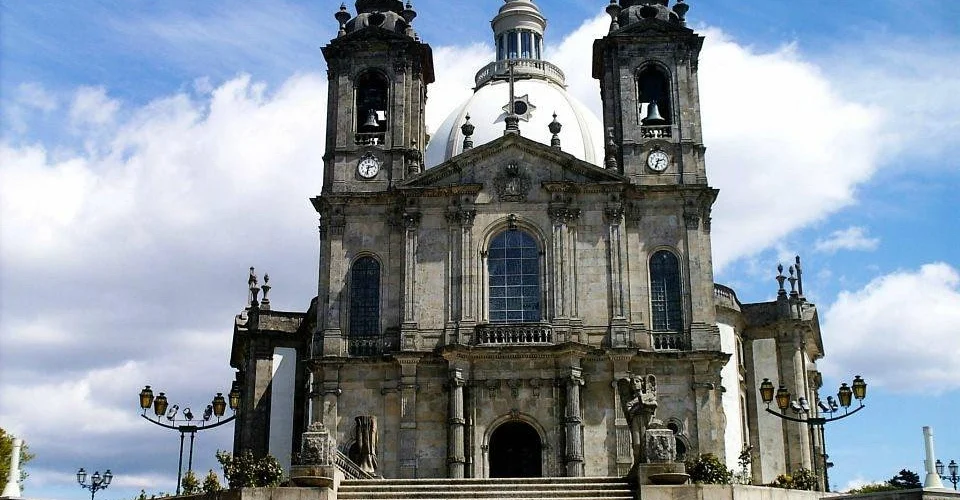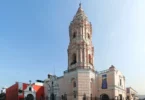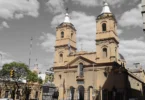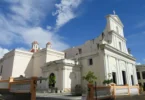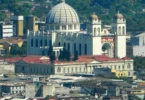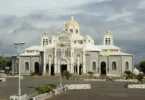Introduction
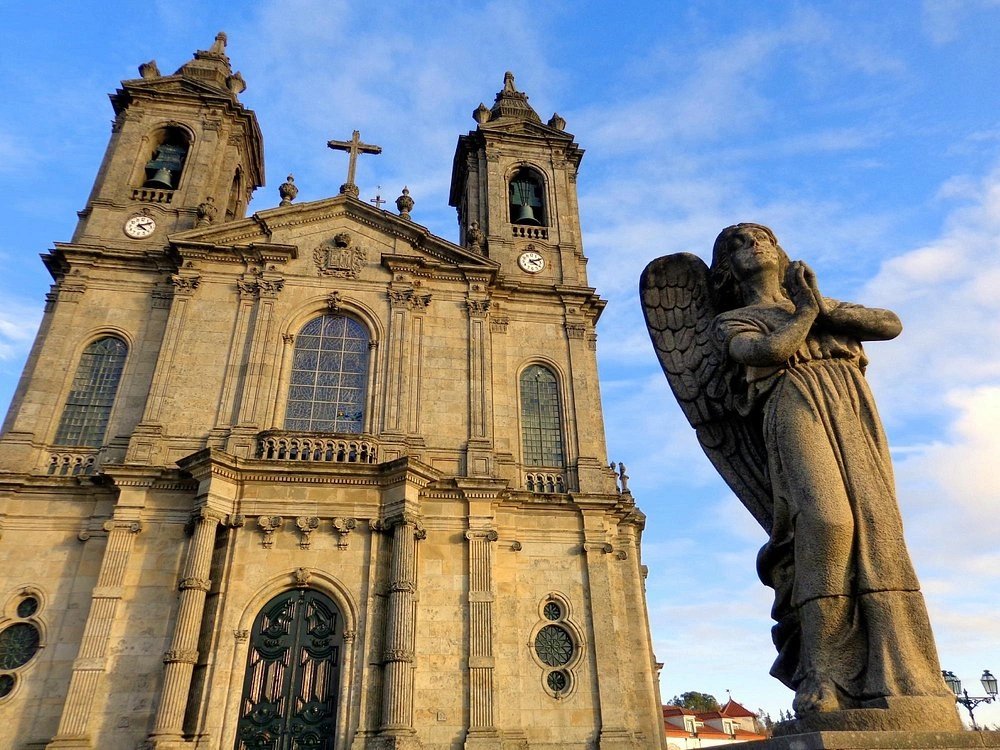
The Sanctuary of Our Lady of Sameiro (Portuguese: Santuário de Nossa Senhora do Sameiro), also known as the Sanctuary of Sameiro or the Sanctuary of the Immaculate Conception of Monte do Sameiro, is a significant Marian shrine and pilgrimage site situated in the northern region of Portugal, near the city of Braga. Perched atop Monte Sameiro, a hill that rises more than 350 meters above the city, the sanctuary is one of the most prominent places of Marian devotion in Portugal, second only in size to the world-famous Sanctuary of Fátima. The sanctuary’s commanding position offers a breathtaking panoramic view over Braga and the surrounding Minho valley, making it not only a center of religious significance but also a popular destination for visitors seeking tranquility and natural beauty. The most striking view is from the top of the basilica’s dome, which presents a sweeping vista of the city and the surrounding landscape.
The Sanctuary of Sameiro has become a major place of pilgrimage, drawing thousands of devotees each year, particularly during the first Sunday of June and the third Sunday of August, which are key dates in the pilgrimage calendar. This vibrant site is a focal point of Catholic worship and is deeply tied to the tradition of honoring Our Lady of Sameiro, the patron saint of Braga. Pilgrims and visitors often ascend the hill to participate in the religious ceremonies, seek solace, and reflect in the peaceful surroundings. In addition to its religious significance, the sanctuary is home to a well-maintained garden that provides a serene setting for prayer and reflection. The garden also features a children’s play area, making it a family-friendly space for relaxation and enjoyment. Nearby, there is also a museum dedicated to the sanctuary’s history and its role in the region’s religious and cultural life. The sanctuary is strategically located just 4 km from the center of Braga and is in close proximity to other significant religious sites, including the renowned Sanctuary of Bom Jesus do Monte, located less than 2 km away. Its location, combined with its architectural beauty and spiritual importance, ensures that the Sanctuary of Our Lady of Sameiro remains a key pilgrimage destination for Catholics and a must-see landmark for anyone visiting the region of Braga.
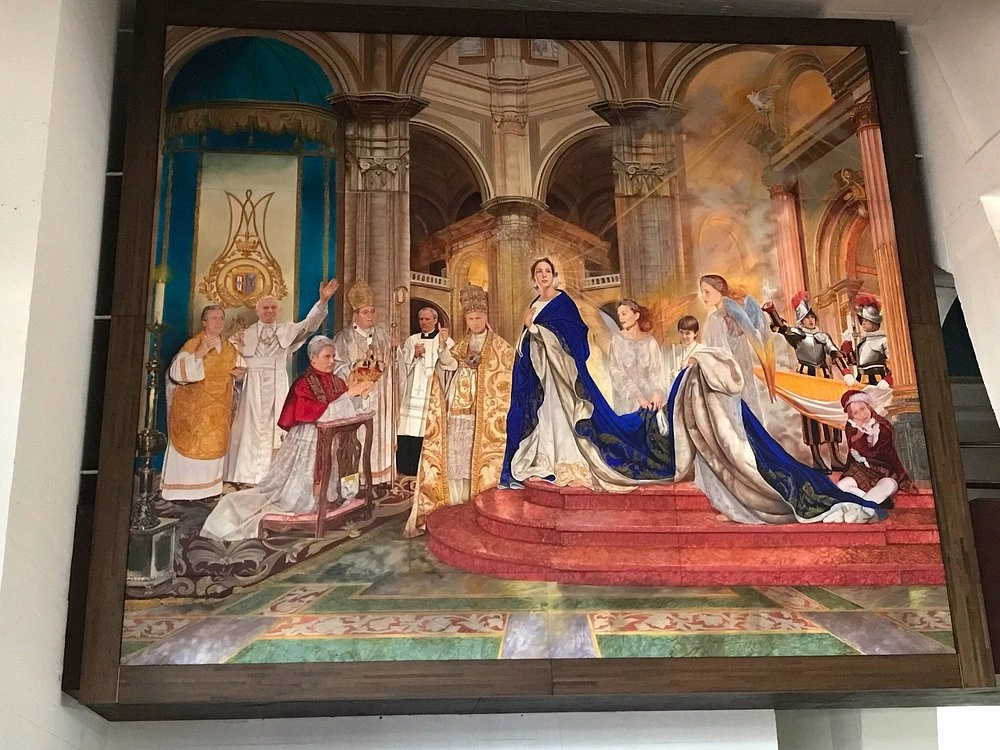
The Sanctuary of Our Lady of Sameiro stands as a profound testament to centuries of Marian devotion in Portugal. Its origins trace back to the mid-19th century and are deeply intertwined with the spiritual and cultural landscape of the country.
Founding of the Sanctuary
The history of the sanctuary began on June 14, 1863, when Father Martinho António Pereira da Silva, the vicar of Braga, initiated the foundation of the shrine. Father Silva, a native of Semelhe, was a key figure in the local devotion to Mary. His vision led to the installation of an image of Our Lady of the Conception on top of Monte Sameiro, the mountain that rises above the city of Braga. This marked the beginning of what would become one of the most important Marian sanctuaries in Portugal, second only to the famous Sanctuary of Our Lady of Fátima in Cova da Iria.
Architectural Development
The construction of the sanctuary itself began in the late 19th century and continued into the 20th century. The basilica, with its imposing dome, stands as the centerpiece of the sanctuary. One of the most striking features of the basilica is its main altar, crafted from polished white granite, along with a silver tabernacle that adds to the grandeur of the space. Visitors are greeted by a vast staircase leading to the entrance of the sanctuary, flanked by two tall pillars. Atop these pillars stand statues of the Virgin Mary and the Sacred Heart of Jesus, symbolizing the deep Marian and Christological devotion of the site.
A New Marian Era
The establishment of the sanctuary came at a time of great transformation in Portugal. Following the Liberal Wars, which ended in the 1830s, religious institutions in the country were left in disarray, with many monasteries and chapels forced to close. The conclusion of these wars marked a period of political and social upheaval, and many devout Catholics felt a sense of loss and disorientation. Amidst this turmoil, the devotion to Our Lady experienced a revival across Europe. In 1854, Pope Pius IX declared the doctrine of the Immaculate Conception as dogma, a belief that Mary, from the moment of her conception, was free of original sin. The Diocese of Braga was the first in Portugal to celebrate this dogma in January 1855 with an elaborate ceremony, which further fueled the Marian devotion in the region.
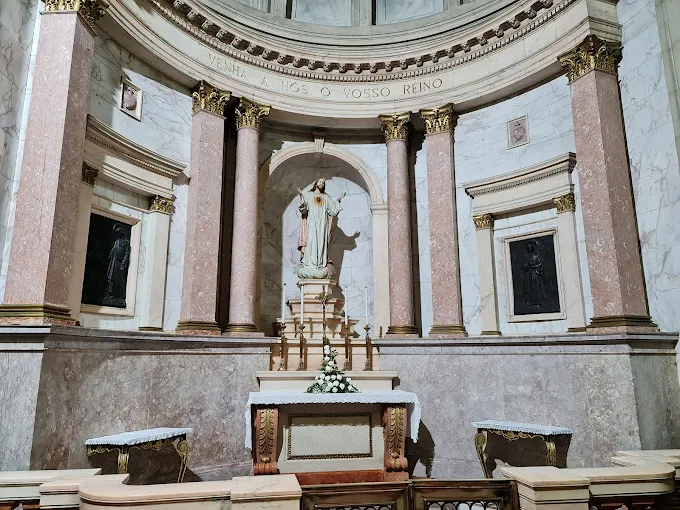
Development and Dedication of the Shrine
Work on the basilica began on July 14, 1863, and by August 28, 1869, an outdoor shrine was officially dedicated. This shrine housed a marble statue of Mary, sculpted by Emidio Carlo Amatucci from Porto. Unfortunately, in 1883, an electrical failure led to the destruction of the statue. A replacement was commissioned, created by the sculptor Antonio Teixeira Lopes, and installed in 1886. The complex continued to evolve over the following decades, with various additions, including the Casa das Estampas (House of Prints), the Rector’s House, the Chapel of the Eucharist, and the crypt beneath the church.
Symbolism and Monuments
The sanctuary is not only a place of worship but also a space dedicated to honoring the theological significance of Mary. At the top of the grand staircase, monuments to the Sacred Heart of Jesus and the Immaculate Conception stand, emphasizing the core themes of Catholic faith represented at Sameiro. Additionally, close to the sanctuary’s entrance are four statues commemorating theologians who were instrumental in the development of Marian theology: Cyril of Alexandria, Alphonsus Liguori, Bernard of Clairvaux, and Anthony of Padua. These statues serve as a reminder of the theological foundation that underpins the devotion to Mary.
Cultural and Religious Significance
The Sanctuary of Sameiro forms part of a larger Marian Shrine Route in Portugal, a network of pilgrimage sites dedicated to Mary. Throughout Portugal’s history, Mary, often referred to as Nossa Senhora, has played a central role in shaping the nation’s religious identity. Many of Portugal’s cathedrals are dedicated to Mary, including those in Porto, Viseu, Lisbon, and Évora, reflecting her enduring importance in the national consciousness. Today, the Sanctuary of Our Lady of Sameiro remains a vibrant center of Marian devotion, attracting pilgrims and visitors from around the world. Its history reflects the resilience of faith and devotion in a country that has long revered Mary as a central figure in its spiritual life.
Architecture of Sanctuary of Our Lady of Sameiro, Braga, Portugal
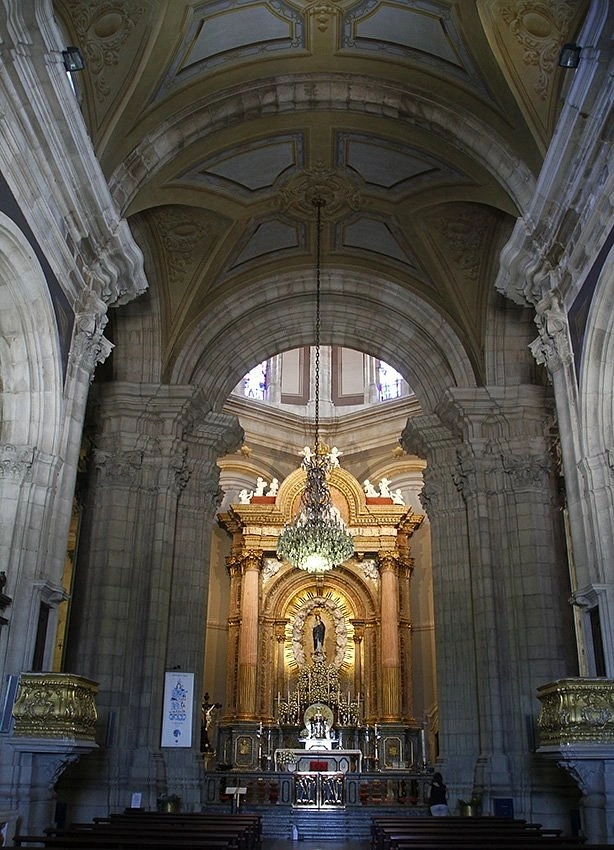
Adornment of the Sanctuary of Our Lady of Sameiro
The Sanctuary of Our Lady of Sameiro is a magnificent religious site that combines neoclassical architectural elements with various artistic works that reflect different aesthetic and religious traditions. While the church itself is generally recognized for its neoclassical style, it is adorned with several notable pieces that enhance its beauty and significance.
Architectural Style and Artistic Features
The sanctuary’s architecture is simple and unassuming in terms of its neoclassical style, which focuses on symmetry, simplicity, and classical forms. However, it is the artistic adornments that truly bring the church to life. One of the most remarkable features is the silver tabernacle located on the main altar. This exquisite piece of craftsmanship stands as a symbol of the sanctuary’s sacred function and adds a touch of elegance to the otherwise modest church design. Another significant element of the sanctuary is the statue of Mary, which occupies a prominent place on the altar. This sculpture was created in Rome by the renowned artist Eugénio Maccagnani and arrived in 1880. The statue is a stunning representation of the Virgin Mary, embodying both the divine and maternal qualities that are central to Catholic devotion. Its arrival marked a key moment in the sanctuary’s history, and it continues to be a focal point for worshippers and pilgrims.
Modern Artworks and Enhancements
In the 20th century, the sanctuary was enriched with additional artworks that reflect a blend of religious symbolism and artistic innovation. One of the notable additions is a series of tile panels located in the crypt, created by the artist Querubim Lapa. These panels, which are traditional in Portuguese art, add a unique and localized touch to the sanctuary’s interior. In the presbytery area, a large artistic panel painted by Oscar Casares was completed between 2005 and 2006. This modern work of art continues the sanctuary’s tradition of incorporating contemporary religious expressions, ensuring that the sanctuary remains relevant and resonant for modern-day worshippers. Additionally, the sanctuary is home to four remarkable sculptures created by Clara Menéres. These sculptures represent Michael, Raphael, and Gabriel, the archangels, as well as the Angel of Portugal. These figures are crafted with great attention to detail and contribute to the sanctuary’s rich religious and artistic environment, elevating the sanctuary’s status as both a place of spiritual and cultural significance.
Recognition of the Sanctuary and Its Marian Statue
Over the years, the Sanctuary of Our Lady of Sameiro has received significant recognition for its religious importance. In 1876, Pope Pius IX granted the decree of Canonical Coronation to the statue of Our Lady of Sameiro, officially recognizing her as a key Marian icon. To commemorate the 50th anniversary of the dogma of the Immaculate Conception, one of the statues of Mary was solemnly crowned on June 12, 1904, by the Papal Nuncio, Archbishop Giuseppe M’acchi, who was delegated by Pope Pius X to perform the coronation ceremony. The sanctuary’s global importance was further affirmed by a visit from Pope John Paul II on May 15, 1982, which brought international attention to the site. On December 8, 2004, the Pope granted the sanctuary the prestigious Golden Rose, a rare papal distinction awarded to religious sites that have provided significant service to the Catholic Church and to society. The Golden Rose is a symbol of the church’s acknowledgment of the sanctuary’s enduring spiritual and cultural contributions.
Our Lady of Sameiro: The Marian Statue and Its Significance
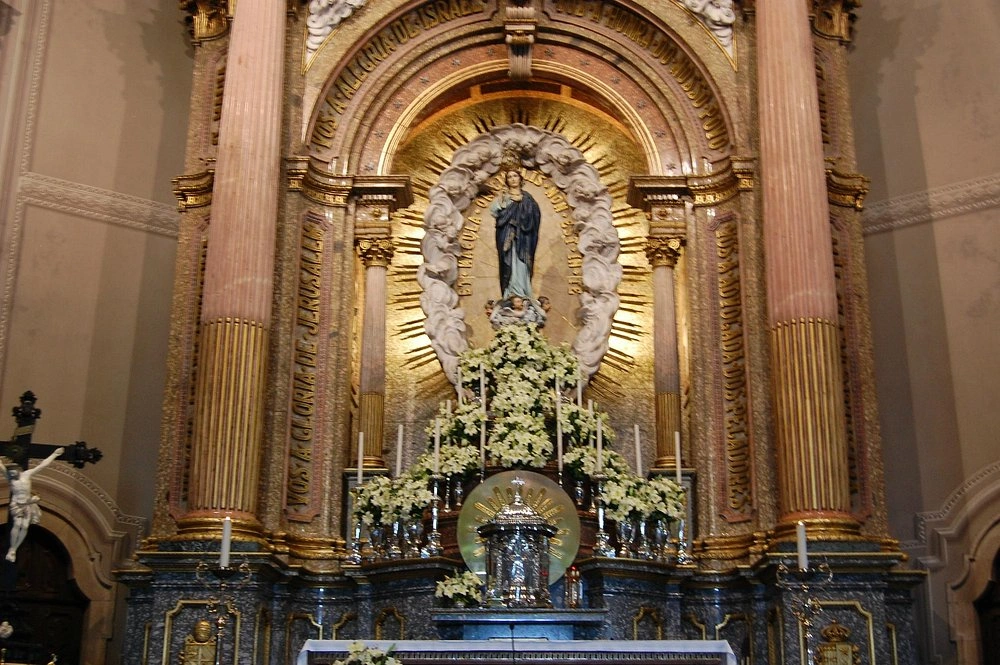
The image of Our Lady of Sameiro holds great importance at the sanctuary. The statue, which graces the main altar, was sculpted in Rome and blessed by Pope Pius IX. It is an exceptional work of art, and its beauty is enhanced by a solid gold crown, weighing 2.5 kg, adorned with diamonds. This crown was offered by the women of Portugal, including Queen D. Amélia of Orleães, in 1904. The statue represents the Immaculate Conception of Mary and serves as a powerful symbol of purity, grace, and maternal love. Braga, the city that houses the sanctuary, was the first in Portugal to dedicate a monument in celebration of the proclamation of the dogma of the Immaculate Conception on December 8, 1854. This moment marked a defining moment for the city’s deep Marian devotion. In his pastoral letter, D. Jorge Ortiga, the Archbishop of Braga, highlighted the profound role of Our Lady of Sameiro in the lives of the faithful, referring to her as a presence that invites people to encounter Christ through the Word and the Eucharist.
The liturgical feast day of Our Lady of Sameiro is celebrated on June 12, according to the Proprium of Braga, a liturgical calendar specific to the Archdiocese of Braga. This day serves as a time for pilgrims to gather in the sanctuary for prayer, reflection, and celebration of the Virgin Mary.
Pilgrimages and Religious Events
The sanctuary holds a special place in the religious life of the region, with two major annual pilgrimages that attract thousands of faithful. The great annual pilgrimage of the Archdiocese of Braga takes place on the first Sunday of June, starting from the Braga Cathedral. Pilgrims walk in a procession towards the sanctuary, honoring Our Lady of Sameiro. Another important pilgrimage occurs on the third Sunday of August, when the statutory pilgrimage begins at the nearby Sanctuary of Bom Jesus do Monte. Both pilgrimages are deeply rooted in tradition and serve as major events of Marian devotion for the people of Braga and beyond.
Spiritual Protection and Influence
The influence of Our Lady of Sameiro extends beyond the sanctuary itself. The House of the Dominican Sisters of Saint Catherine of Siena (established in 1934), the Carmelite Missionary Seminary (founded in 1967), the Monastery of Santa Cruz of the Cruzios Fathers (opened in 1979), and the Society of Apostolic Life Heralds of the Gospel are all institutions that fall under the spiritual protection of Our Lady of Sameiro. These organizations continue to contribute to the religious and social fabric of Portugal, carrying forth the Marian devotion that the sanctuary represents.
Feast Day
Feast Day : 12 June
The feast day of Our Lady of Sameiro is celebrated on June 12 each year. This date is specific to the Proprium of Braga, the liturgical calendar of the Archdiocese of Braga, where the sanctuary is located. On this day, pilgrims and devotees gather at the sanctuary to honor Our Lady of Sameiro and participate in various religious ceremonies and celebrations.
Church Mass Timing
Monday to Friday : 10:00 AM , 4:50 PM
Saturday : 10:00 AM , 4:30 PM
Sunday : 7:30 AM , 9:30 AM , 11:30 AM , 4:30 PM
Church Opening Time:
Monday to Sunday : 10:00 am – 1:00 pm., 2:00 pm – 5:00 pm.
Contact Info
Address : Sanctuary of Our Lady of Sameiro, Braga, Portugal
Av. Nossa Sra. do Sameiro 44, 4715-616 Braga, Portugal
Phone : +351 253 303 402
Accommodations
Connectivities
Airway
Sanctuary of Our Lady of Sameiro, Braga, Portugal, to Francisco Sá Carneiro Airport (OPO), distance between 45 min (61.3 km) via A3.
Railway
Sanctuary of Our Lady of Sameiro, Braga, Portugal, to Estação de Braga Braga, distance between 20 min (11.2 km) via N130-3 and N103.

